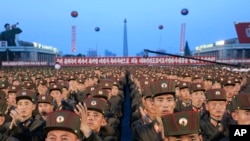Experts say an undeclared North Korean intercontinental ballistic missile base near China, detected via satellite imagery, indicates that Pyongyang has expanded its locations from which it can deploy long-range missiles to attack the U.S. mainland.
North Korea has diversified the missiles in its arsenal, as evidenced by the 11 missiles tested in January. It tested what it called hypersonic missiles, tactical guided missiles, cruise missiles and an intermediate-range ballistic missile capable of striking the U.S. territory of Guam. It stopped short of testing an ICBM.
North Korea's Foreign Ministry boasted Tuesday of its capability to strike the U.S. "There's only our country on this planet that can shake the world by firing a missile with the U.S. mainland in its range," Pyongyang said.
All the while, North Korea has been working to expand a base from where it can deploy ICBMs for wartime use, said experts analyzing satellite images reported by the Center for Strategic and International Studies (CSIS) this week.
Jeffrey Lewis, director of the East Asia Nonproliferation Project at the Middlebury Institute of International Studies at Monterey, said commercial satellite photos indicate Pyongyang is ready to station ICBMs at the Hoejung-ni missile base in Chagang province after having tested them several times in 2017. The province borders on China's Jilin and Liaoning provinces.
Possible ICBM deployment
"This isn't a sign of an ICBM test," Lewis said, referring to the satellite photos indicating the completion of the base. "This is a sign that North Korea is deploying some ICBMs. … It's an operation base to use the missiles in a war."
He continued: "The [ICBM] tests that they did in 2017 validated two ICBM designs. They are probably deploying some of those ICBMs at this location, which is why we saw the big uptick in construction in 2018."
North Korea tested three ICBMs in 2017 and conducted its sixth nuclear test, drawing wide condemnation from the international community.
"Although construction began almost 20 years ago," the CSIS report said, "the Hoejung-ni missile operating base represents one of the latest Strategic Forces bases to be completed." North Korea's strategic forces include short-range and intermediate ballistic missiles.
Joseph Bermudez, one of the authors of the report and a senior fellow for imagery analysis at CSIS, said, "This missile operating base is reported to be selected for the deployment of ICBMs."
Of North Korea's approximately 12 missile bases, two to three are for ICBMs, according to Lewis.
Ian Williams, deputy director of the Missile Defense Project at CSIS, said the missile base shows North Korea is expanding locations from where it can launch attacks.
"What we're seeing is North Korea building a number of locations from which it can fire missiles," Williams said. "By spreading [the bases] out more, you can make them more resilient to attack and harder to destroy before they launch."
The Hoejung-ni missile base is in the remote rugged mountains of north-central Chagang province. North Korea launched its Hwasong-12 intermediate-range ballistic missile from the province on January 30.
"The more enemy territory you have to traverse to get to your target, generally considered, a bit more challenging" to attack, said Williams.
"It's still a tough challenge for North Korea to keep their missiles invulnerable from an attack" because it is a small country, "which I think is one of the reasons why they've been diversifying not only their locations but their delivery platforms," he said.
To protect the location of its weapons, North Korea has launched missiles from trains, submarines and road-mobile transporter erector launchers (TEL).
Proximity to China
Experts also noted the base's location, which, at 25 kilometers from the Chinese border, poses a deterrent to a U.S. or South Korean attack.
Bruce Bennett, a senior defense analyst at the Rand Corporation, said that "having the base close to China will make the ROK/U.S. less likely to fire a preemptive attack at the base because of the risk that a ROK/U.S. missile or aircraft attacking the base might accidentally enter Chinese territory and start a war." "ROK" stands for Republic of Korea, South Korea's official name.
David Maxwell, a senior fellow at the Foundation of Defense for Democracies, said, "If the U.S. assess that this is an ICBM launch base and that it will be used to strike the U.S., it will be attacked regardless of [a] possible response" from China.
VOA's Korean Service contacted the Chinese Embassy in Washington and North Korea's Mission to the U.N. asking for comments but received no response.
Responding to the CSIS satellite report, U.S. Pentagon spokesperson Lieutenant Colonel Martin Meiners told VOA's Korean Service that the U.S. does not speak to "matters of intelligence or commercial imagery analysis."
"However, we have been very clear on the threat posed by the Democratic People's Republic of Korea's missile programs, and our commitment to the defense of the ROK, Japan and the U.S. homeland," said Meiners, who used North Korea's official name in his response on Tuesday.
Responding to VOA Korean Service's question about North Korea's ICBM base Wednesday, State Department principal deputy spokesperson Jalina Porter said, "The United States has a vital interest in deterring the DPRK."
Porter continued: "That includes defending against its provocations or use as a force, limiting the reach of its most dangerous weapons programs, and, above all, keeping the American people, deployed forces and our allies safe."
Young Gyo Kim contributed to this report.











